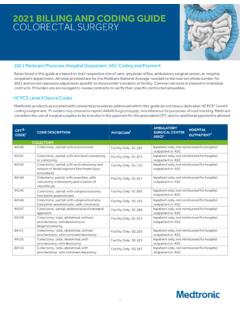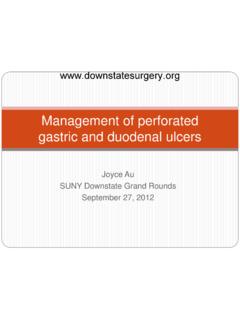Transcription of Types of mutations - Columbia University
1 1 Lecture 10 DNA REPAIR CONTINUEDT ypes of mutations - Deletions a part of the DNA is missing anywhere from 1 base pair to parts of Insertions of new DNA again ranging from 1 to many base pairs- Point mutations ; a change in the nucleotide. Two Types - Transitions Purine to other purine or pyrimidine to other Transversions: Purine to Pyrimidine or Pyrimidine to ----------GAATTC---------3 3 ----------CTTAAG---------5 Substitutions:5 ----------GATTTC---------3 3 ----------CTAAAG---------5 5 ----------GAGTTC---------3 3 ----------CTCAAG---------5 Deletion:5 ----------GAATC----------3 3 ----------CTTAG----------5 1999 Lee Bardwell5 ----------GAATTC---------3 3 ----------CTTAAG---------5 Insertion:5 ----------GAACTTC---------3 3 ----------CTTGAAG---------5 Duplication.
2 5 ----------GAATATTC--------3 3 ----------CTTATAAG--------5 2000 Lee BardwellSubstitutions that occur in protein-coding sequences Silent- changes a codon, but not the encoded amino acid residue possible because the code is degenerate Missense- changes the encoded residue Nonsense- an amino acid-encoding codon becomes a stop codon 1999 Lee BardwellEXAMPLES - substitutions Silent-TGT (Cys)--> TGC (Cys)GCA (Ala)--> GCN (Ala)(N = any) Missense- TGT (Cys)--> TGG (Trp) Nonsense- TGT (Cys)--> TGA (STOP) 2000 Lee Bardwell2 Frameshift exampleNH2- Met-Thr-Leu -Lys -COOH5 -ATG-ACC-TTG-AAA-TAA-3 NH2-Met-Pro -COOH5 -ATG-CCT-TGA-AAT-AA-3 Delete A 2000 Lee BardwellSNPsSNPsSNPsSNPsSNPs can have variable effects SNPs can have no effect.
3 Their change can be neutral to the protein, a silent mutation. SNPs can have a subtle effect, lys to arg(both are polar basic). This is what we suspect is happening in complex genetic diseases SNPs can have measurable effects (a pronounced reduction in activity). SNPs can change protein function. A new substrate might be recognized. SNPs can complete eliminate the proteins ability to of DNA damage Tolerated (ignored) Repaired Can kill the cell or cause the cell to kill itself Can become fixed, resulting in a mutation (Note: fixed <> repaired)Examples of mutation fixation Replication of an unrepairedmisincorporation Replication of an unrepairedcytosine deamination(deaminated cytosine = uracil)Human Genome Haploid size = 3300 Megabase pairs = x 109(= billion) base pairs Diploid size = double that Misincorporation (10-5) x not proofread (10-2) x escape mismatch repair (10-3) = 10-10 Thus, less than one replication error is fixed per cell divisionMutation Rate per bp 10-9per base pair per cell division This refers to mutations that are not repaired ( they re fixed)
4 Thus, there are at least six new base changes in each kid that were not present in either parent, but this is an underestimate as there s more since they accumulate in the germ line stem cells as the father ages Remember, most of these are not in genesFrom all sources (misincorps, damage):Mutation rate per geneFrom all sources (misincorps, damage): Approx 10-5per gene per cell division Human genome contains 30,000-100,000 genes Thus, roughly one new mutation (allele) is created per cell division (most likely recessive)DNA mismatch repair1. MutSbinds to a mismatched bp2. MutS-DNA complex binds MutL3.
5 The MutS-MutL complex translocates along the DNA in both directions, forming a On encountering a hemimethylated GATC palindrome, the MutS-MutL complex recrutesMutH4 MMR cont5. MutS-MutL recruits UvrD helicase, which in concert with an exsonuclease, separates the strands and degradates the nicked strand from the nick to beyond the nick is 3 side: exsonuclease I (3 ->5 exsonulceaseIf nick is 5 side: RecJ or exsonucleaseVII (5 ->3 exsonuclease)6. DNA pol III fills gap and DNA ligaseseals nickUracil DNA glycosylaseand BER An enzyme that removes Uracil from DNA Resulting abasic site is filled in by polymerase Uracil in DNA comes mainly from deaminationof cytosine That may be why DNA uses thymine instead of uracil If the uracil isn t removed, it will pair with A, causing C/G --> T/A DNA damageThe discovery of NER Setlow found three mutations in E.)
6 Coli that rendered the cells sensitive to UV damage. The genes were named UvrA, UvrB and UvrC for UV resistance. Using cell-free extracts, Sancardetermined the mechanism of uvrABCwhich has been refined over the process of uvrABC excision of DNA damage is called nucleotide excision is a ATP-helicasethat moves along the DNA looking for damageWhen DNA damage isencountered the complex arrestsat the site. The DNA is bentuvrA is released and uvrCis recruited to the complex 5 NER in E. coli continuedtwo single strand nicks are placed to the 3' side of the dimer (4 to 5 nucleotides) and to the 5' side of the dimer (8 nucleotides) helicase II (uvrD)
7 Unwinds 12 - 13 b fragment containing the dimer, ATP hydrolysis required DNA polymerase I fills in the gap dNTPs required DNA ligase seals the single strand break ATP hydrolysis to AMP required NER in mammalian cellsA disease in humans known as Xeroderma Pigmentosum XP is a rare inherited disease of humans which, among other things, predisposes the patient to pigmented lesions on areas of the skin exposed to the sun and an elevated incidence of skin turns out that XP can be caused by mutations in any one of several genes - all of which have roles to play in NER. James Cleaver went around and collected cells from hundreds of these patients.
8 He then figured out that the disease was made up of eight genes named XP-A through XP-G plus one called XP-V for are 8 XP complementation groups XP-A participates in photoproduct recognition and DNA binding This binding may be followed by the formation of a quasi-stable complex consisting of XPA, XPC, human single-strand binding protein (RPA/HSSB), and TFIIH, which then acts as a nucleation site for binding of the incision/ excision enzymes. XP-B is a 3 -> 5 DNA helicase that may be involved in unwinding the DNA 5'-ward of a damaged base XP-C is a single-stranded DNA binding protein that is essential for repair of the nontranscribed regions of the genome, that acts in the initial step of damage recognition.
9 XP-D is a 5' 3' helicase, a component of transcription factor TFIIH may be involved in 3'-ward unwinding of the DNA in the vicinity of a damaged base XB Genes continued XP-E is thought to be involved with the recognition of damaged DNA because it has the capacity to bind to UV-damaged DNA XP-F in association with the ERCC1 protein, incises DNA on the 5' side of the damaged site XP-G incises DNA 3' to the damaged site XP-V protein is a low-fidelity class Y DNA polymerase, that can replicate UV-induced pyrimidine dimers in vivo with the insertion of the correct bases in the daughter strand CSA likely participates in a CSB/RNA polII complex stalled at damaged sites in transcriptionally active DNA that helps remove the stalled RNA polII from the DNA damage site.
10 CSB is believed to be a DNA helicase that is required for ubiquitinating RNA polII for its remove and degradation at sites of DNA XP proteins are XPA, which encodes a protein that binds the damaged site and helps assemble the other proteins needed for NER. XPB and XPD, which are part of TFIIH. Some mutations in XPB and XPD also produce signs of premature aging. XPF, with ERCC1 cuts the backbone on the 5' side of the damage XPG, which cuts the backbone on the 3' side. XPC interacts with HR23B in GGR and recognizes damage XPD is a DNA helicase in in transcription complex VPV is a by-pass polymerase6 Cleaver s study: Complementation groups of XP+Fuse two XP cells fromdifferent patients togetherFused cellUV irradiate Plate cells and check survivalresistantsensitiveDeveloping an in vitro DNA repair systembreak cellsLow speedspinNuclei and largefragments soluble extractHigh saltextractionCentrifuge andtake sup.















